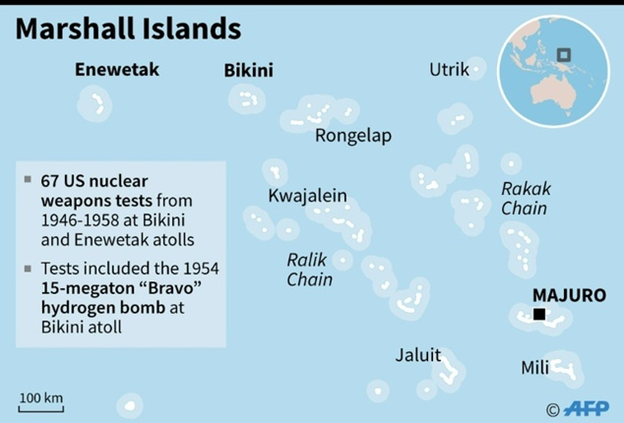I am writing this in the “Crow’s Nest.” This is my favorite place to hang out on the ship. It is located on the 9th or “Sports Deck.” The Crow’s Nest is both the highest room on the ship and the one closest to the bow. At 5:00am, I had the place all to myself but now it is 6:55 and I am overhearing those who arrived for the stretching class discussing the prospects of snow in Japan.
The horizon, which was pitch black when I arrived, has gradually been transformed to blue-gray ocean and lighter gray sky. This transformation was due to the sun rising in the east as we continued heading west.
I took a quick break for an early breakfast in the Lido because there will not be time after Mass at 8:00am because “On Deck for a Cause,” a walk to raise money for cancer research, begins at 9:00am. Cancer research is certainly a cause I support.
We are slowly sailing away from the tropical island paradises near the equator. There were dramatic differences between our last two ports of call. (I am not really sure what ‘ports of call’ really means but it seemed like the right words to make me look like a travel writer.)
Our next stop after Honolulu was a little town in the Marshall Islands called Majuro. There were no excursions offered for this visit. A shuttle transported us a couple of miles to what might be considered the center of the town. I was told that during WWII there were 30 native inhabitants of the island and now there are 30,000.
It was clear to me that the people of Majuro were making a big effort at hospitality. They had set up chairs under an awning in a grassy park and had assembled their local talent to entertain us with music. There was a long line of tables laden with a wide variety of hand-crafted items. The tables were also shaded by an awning. The majority of what I saw displayed incorporated local grasses, leaves and palm fronds woven into artistic or practical items. Sea shells were incorporated into the handicrafts. One item which amused me only because I had seen it in the past was a woven cigarette pack holder.
Very few cruise ships stop at Majuro. I felt sorry that I had no inclination to purchase any of these crafted items since I already have much too much stuff at home. I did not have any requests from the folks back home for island souvenirs. I hope, however, that my fellow passengers did make purchases because the purchases would boost the local economy. The people of Majuro, at least, were blessed with a sunny day in which to promote their wares. Thus far we had good weather at every stop. I heard that, before our arrival in Hilo, that community had experienced two days of non-stop rain.
In some ways, I felt like I was visiting a town in the 1950s. As a matter of fact, the school girls, who apparently were dismissed from their classes to enjoy the music and visitors, wore uniforms almost identical to what I wore to school in the 1950s.
A couple of women from the ship engaged the girls in holding hands and dancing in a circle. I spoke with one of the ladies later and she said this was the highlight of her visit to Majuro.
The little town had a small museum. The focus of the museum was the people who had lived there in the past. There were pictures of women wearing skirts woven out of grass but not anything like the hula skirts we associate with Hawaii. There were also pictures of the mushroom shaped clouds resulting from the atomic testing which our country carried out in the area. (Later I saw a sign related to collecting compensation for suffering exposure to the radiation which resulted from the blasts.)
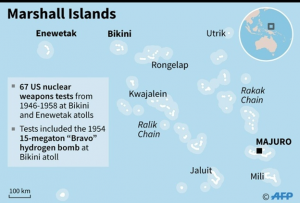 I would have expected that the people, who lived in what seemed to me to be a tropical paradise, would have been laid back and relaxed. Instead, I learned that the history of the people is one of fierce fighting.
I would have expected that the people, who lived in what seemed to me to be a tropical paradise, would have been laid back and relaxed. Instead, I learned that the history of the people is one of fierce fighting.
I saw one thing in the display of weapons which reminded me of a modern invention. The warriors used spears with jagged barbs. These spears not only inflicted pain going in but also could inflict pain tearing flesh when being removed. The design is almost identical to a clever device I discovered on line when I was trying to find a way to unclog my sink! I wonder if the holder of that patent was a descendant of the fierce Polynesian warriors.
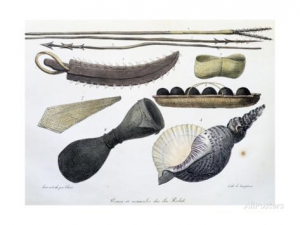 After sailing all night, Amsterdam’s next stop was Guam. Everybody on the ship had to go through special customs and immigration screening before being permitted to disembark. Asan, the city in Guam we visited, was totally modern. Once we cleared screening, Mary and I took a shuttle to the local indoor shopping mall. The shops and even the food court were just like in San Diego. The only difference was a children’s play area where I noted the children all removed their shoes before playing on the equipment.
After sailing all night, Amsterdam’s next stop was Guam. Everybody on the ship had to go through special customs and immigration screening before being permitted to disembark. Asan, the city in Guam we visited, was totally modern. Once we cleared screening, Mary and I took a shuttle to the local indoor shopping mall. The shops and even the food court were just like in San Diego. The only difference was a children’s play area where I noted the children all removed their shoes before playing on the equipment.
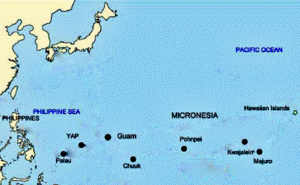 After sailing all night, Amsterdam’s next stop was Guam. Everybody on the ship had to go through special customs and immigration screening before being permitted to disembark. Asan, the city in Guam we visited, was totally modern. Once we cleared screening, Mary and I took a shuttle to the local indoor shopping mall. The shops and even the food court were just like in San Diego. The only difference was a children’s play area where I noted the children all removed their shoes before playing on the equipment.
After sailing all night, Amsterdam’s next stop was Guam. Everybody on the ship had to go through special customs and immigration screening before being permitted to disembark. Asan, the city in Guam we visited, was totally modern. Once we cleared screening, Mary and I took a shuttle to the local indoor shopping mall. The shops and even the food court were just like in San Diego. The only difference was a children’s play area where I noted the children all removed their shoes before playing on the equipment.
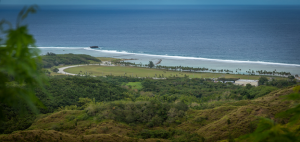 Mary and I had just minutes to re-board the ship and assemble in the Queens’s Lounge to go on an afternoon tour called “Hatanga Highlights and Latte Stone Park.” This tour began with a scenic drive to the Asan Bay Overlook. Although the view is peaceful now, during WWII the Japanese overtook the Island and later our American troops fought hard and reclaimed it. There were statues at the overlook and monuments at Asan Beach Park commemorating these battles. On a more ‘upbeat’ note, we visited Latte Stone Park. We saw ancient stones which may have been used as foundations for structures such as homes. This is still very mysterious to me because I cannot imagine how anyone could have shaped these stones and moved them around.
Mary and I had just minutes to re-board the ship and assemble in the Queens’s Lounge to go on an afternoon tour called “Hatanga Highlights and Latte Stone Park.” This tour began with a scenic drive to the Asan Bay Overlook. Although the view is peaceful now, during WWII the Japanese overtook the Island and later our American troops fought hard and reclaimed it. There were statues at the overlook and monuments at Asan Beach Park commemorating these battles. On a more ‘upbeat’ note, we visited Latte Stone Park. We saw ancient stones which may have been used as foundations for structures such as homes. This is still very mysterious to me because I cannot imagine how anyone could have shaped these stones and moved them around.
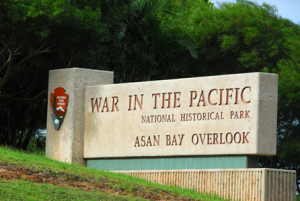
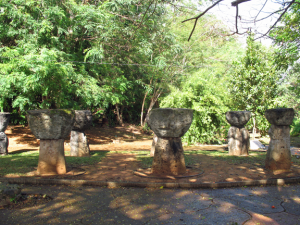
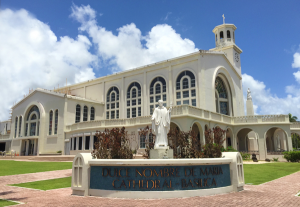 At one point on our tour, we stopped very close to a beach. I wanted to touch the water. I proceeded cautiously to do just that. The shore was not sand but the roughest collection of various sized rocks imaginable. I touched the tip of one of my shoes to the water and hurried back to soft grass. When I returned to the bus, a fellow tourist explained the beach was composed of broken coral.
At one point on our tour, we stopped very close to a beach. I wanted to touch the water. I proceeded cautiously to do just that. The shore was not sand but the roughest collection of various sized rocks imaginable. I touched the tip of one of my shoes to the water and hurried back to soft grass. When I returned to the bus, a fellow tourist explained the beach was composed of broken coral.
The final stop in our tour reminded me a lot of San Diego. I felt like I was in Old Town, the International Cottages in Balboa Park , or at the San Diego Mission. We had the opportunity to enter a special Catholic church by way of the church’s gift shop. The church was a cathedral but had moved up in status to “Basilica” when Pope John Paul II had celebrated mass there. The translation of the name of the church in English is “Church of the Sweet Name of Mary.”
The time for the ship to depart Guam was originally set of 4:30pm but due to delays cause by customs and immigration when we arrived, departure was delayed to 6:30pm. Mary and I were glad to have had our Guam adventures and equally glad to return to our floating hotel.

